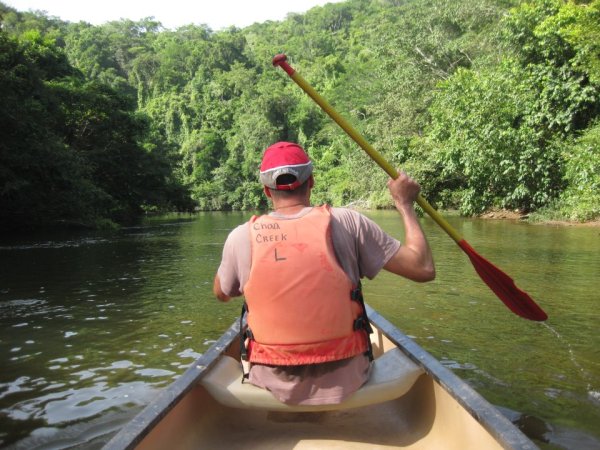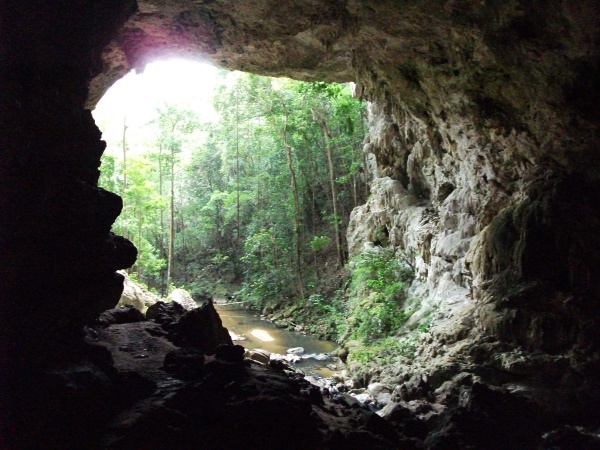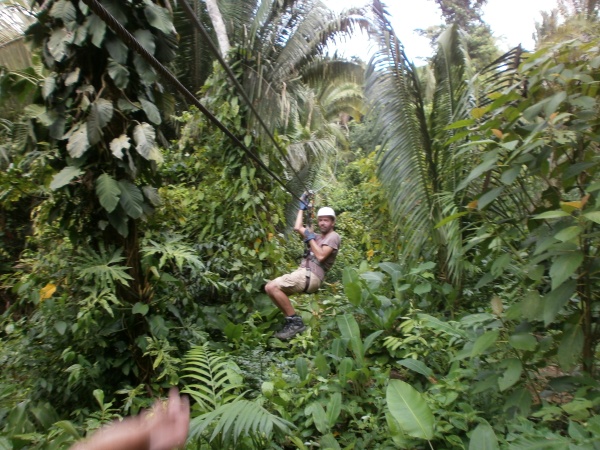In the previous post I focused on the quintessentially Belizean activities of scuba diving and snorkelling. But Belize has plenty more ingredients for an adventurous holiday, both on water and land.
Sailing
Belize’s clear Caribbean waters are as inviting from above as they are from below. Along with snorkelling, the northern cayes are great for sailing too – a day’s sailing, with swimming, snorkelling and a beach barbecue, is a perfect way to spend a day. There are dozens of tour companies in San Pedro offering day trips, as well as my personal favourite, the sunset cruise – although my fondness for it could have something to do with the free rum punch that the tour guides provide. And in Caye Caulker, a company called Raggamuffin Tours does multi-day trips all the way down the coast to Placencia, camping at various islands along the way, including Tobacco Caye.
Birding and Wildlife Watching
Belize is a twitcher’s heaven – over 570 species have been recorded in the country (80% of them endemic), making Belize a popular destination for birdwatchers. The tropical climate makes Belize popular with winter migrants from North America (both avian and human, as it happens), and the diverse range of environments (jungle, savannah, wetland and coastal) attracts an equally diverse range of inhabitants. Many of the upscale jungle lodges (including Chaa Creek) proudly announce how many hundreds of species have been spotted in their grounds, but you can see exotic birds anywhere outside the cities (and even in the cities, it’s common to see hummingbirds flitting about in people’s gardens and pelicans soaring above the seashore). Red-footed boobies on Half Moon Caye, peregrine falcons in Cockscomb Basin, jabiru storks in Crooked Tree, scarlet macaws in Red Bank, keel-billed toucans in Mountain Pine Ridge – there are enough to keep the most dedicated birders happy.
Belize is also home to a wide variety of mammals, including jaguars and other wild cats (although your best chance of seeing any of them is in the zoo!). There are troops of black howler monkeys in forests throughout the country, but they’re especially numerous at the Community Baboon Sanctuary, where you can get up close and personal with these noisy (but very cute) animals. Manatees are large aquatic mammals that live in coastal lagoons, river mouths and near cayes – these fat, blubbery ‘sea cows’ can be best seen in sanctuaries at Swallow Caye and Gales Point, munching on sea grass and bobbing around the mangroves.
Kayaking and Canoeing
Along with sailing, San Pedro and Caye Caulker are also popular kayaking spots – the shallow, sheltered waters of the reef means that the sea is never too rough, and the clear water and bright sunshine allows you to see almost as much as if you were snorkelling. You can rent kayaks from almost any of the tour agencies in San Pedro, and in Caye Caulker you can combine a guided kayak trip with the satisfaction of helping a good cause – for a donation, the children of the island’s only high school, the Ocean Academy (in conjunction with the Sea Dreams Hotel) take tourists out on the water. You get to see things that you wouldn’t if you went out on your own, you get a local’s perspective on island life (and a local’s knowledge of the flora and fauna – many of the kids have lived on the island all their lives). Plus you get to contribute to an important part of Belize’s future – education isn’t free (and most people are low- and middle-income), so the extra money is very important (lack of money is the main reason why over half of all Belizean children drop out of high school). So if you’re thinking of kayaking at Caye Caulker, the Ocean Academy is the place to do it (thanks to Holger and Kerstin for recommending this).
Canoeing can be done inland on several of Belize’s rivers – many of Cayo’s jungle lodges (including Chaa Creek) provide canoes for their guests to use on the Macal and Mopan rivers, and tour agencies in nearby San Ignacio rent them out. Probably the most unusual canoe trip in Belize is done on the underground river that flows through Barton Creek Cave – you follow the subterranean river into chambers containing Maya artefacts and the remains of human sacrifices.
Hiking
Many of the upscale jungle lodges have hiking trails and guided walks on their grounds, but if you’re not staying anywhere fancy in the forest, Cockscomb Basin Wildlife Sanctuary, Mayflower Bocawina National Park, Shipstern Nature Reserve, and Crooked Tree Wildlife Sanctuary have networks of trails that you can walk on your own or with a guide. Crooked Tree and Shipstern are in the north and so they’re fairly flat, while Cockscomb and Mayflower are in the south and have mountainous terrain (meaning you sweat more, but you get great views at the top of the hills); they also have waterfalls and swimming holes (which are very pleasant after all that sweating). Cockscomb, Mayflower and Crooked Tree have accommodation inside the park (although all four areas are accessible from nearby villages or towns). There are also plenty of hiking opportunities in Toledo district, where you can stay in Maya villages and hike through the jungle to caves, sinkholes and Maya ruins.
And if you’re more hardcore than all that, and a day’s hike is too soft for you, there are guides who will take you on three-day treks up Victoria Peak (one of the highest mountains in the country), or on jungle survival courses that are taught to the British Army. The tropical jungle is hot, humid and exotic – huge trees, hanging vines, moss and ferns, plus colourful birds, noisy monkeys, and more insects than you’ve ever seen before – don’t forget the bug spray!
Caving and Cave-Tubing
The karst topography of Belize means that there are many, many caves – a bedrock of soft porous limestone + lashings of rain = lots of holes in the ground. Western Belize is where the most famous caves are located; it’s also home to the largest cave system in Central America, which stretches over 60km under the Maya Mountains and into Guatemala. To the ancient Maya, caves were the entrance to the underworld, and the home of various capricious gods that needed regular propitiating (often with some spilled blood, and sometimes with human sacrifices). As a result, many caves contain relics of Maya ceremonies, offerings and sacrifices – from rock carvings to pottery shards to human skeletons. This historical/archaeological element makes cave exploration more interesting in Belize than in many other caving countries, and it’s worth checking out at least one famous cave while you’re here.
The most interesting caves are Actun Tunichil Muknal (ATM) and Barton Creek. The all-day trip to the ATM cave is one of the most adventurous things to do in Belize, a unique tour encompassing speleology, Maya spirituality, natural history, and plenty of physical exertion (including swimming in some very cool water and squeezing through some disturbingly-small spaces, often at the same time). Barton Creek cave is similar but less physically demanding – a canoe trip on an underground river, following it into chambers containing Maya artefacts and the remains of human sacrifices.
A related activity that’s all the rage in Belize is cave-tubing – floating downriver into a cave on an inflated inner tube. Although not as adventurous as proper caving, it’s an entertaining alternative, and it’s cheaper and quicker. The two most famous places to cave-tube are at either end of the Caves Branch River (rather confusingly, both places are called Caves Branch) – at the site east of Belmopan you can tube into the beautiful Crystal Cave, and at the site south of Belmopan you can combine tubing with other spelunking activities, including abseiling (rappelling). Cave-tubing is very popular with cruise ship tourists and other short-term visitors (many of whom combine it with zip-lining to make a day tour).
Zip-Lining
Another activity that’s very popular in Belize is zip-lining – whizzing through the treetops from platform to platform on a steel cable, while dangling underneath it in a safety harness. As well as being fun (and eco-friendly), zip-lines give you access to the hard-to-reach parts of the jungle, i.e. the rainforest canopy. If you fancy a fast-moving, bird’s-eye view of the forest, you can zip-line at a number of lodges that have courses on their grounds, including Mama Noots. You can also do it at the aforementioned Caves Branch (along with cave-tubing).
But this list isn’t definitive; it’s merely a shortlist of my favourite activities to do here (and the ones that I consider to be the most ‘Belizean’). There’s also fishing, windsurfing and kitesurfing, cycling, horseback riding, bamboo rafting, WWOOFing, nature research, and probably some others I’ve missed.
Finally (and thanks to my friend Vivienne Goulbourn for reminding me of this), I should add that one of the cheapest, most relaxing, most Belizean (and most enjoyable) activities is to find a hammock and kick back with a beer or a rum :-)






